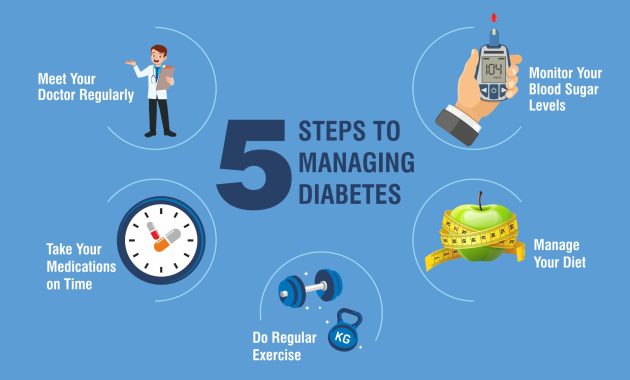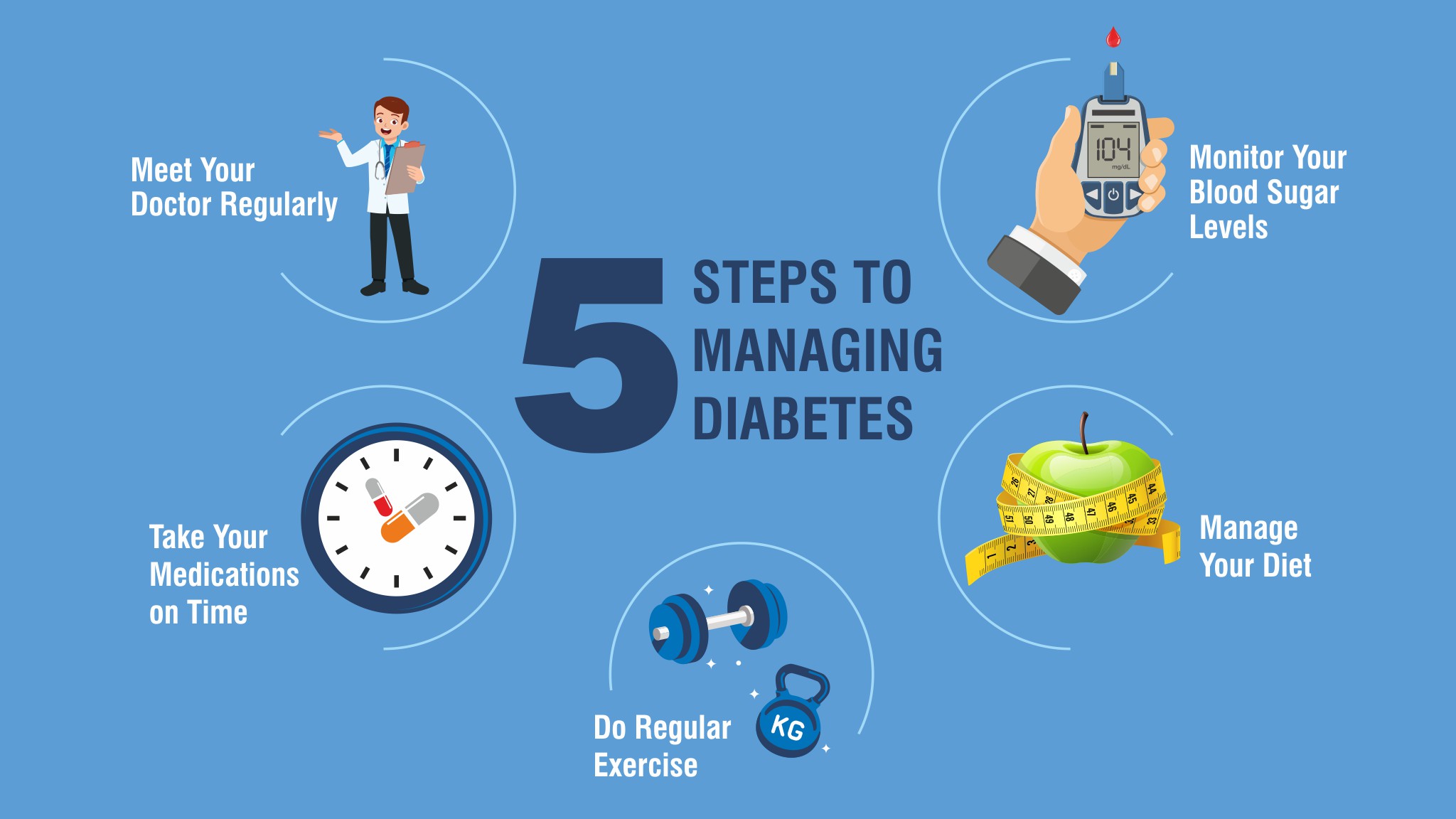
How to Handle Diabetes and Still Eat What You Love: A Guide to Delicious and Diabetic-Friendly Living
The diagnosis of diabetes can feel like a life sentence, a decree dictating a stark shift in lifestyle and, perhaps most dishearteningly, a complete overhaul of your relationship with food. Suddenly, the joy of a spontaneous ice cream cone or a hearty plate of pasta seems like a distant memory. But what if I told you that you don’t have to sacrifice the pleasure of eating to manage your diabetes? This is the crux of the matter: how to handle diabetes and still eat what you love. This article aims to provide a comprehensive guide, debunking myths, offering practical advice, and empowering you to embrace a delicious and fulfilling life, even with diabetes.
Understanding Diabetes: A Quick Refresher
Before we delve into the culinary aspects, let’s establish a foundational understanding of diabetes. Diabetes is a chronic metabolic disorder characterized by elevated blood glucose (sugar) levels. This occurs when the body either doesn’t produce enough insulin (Type 1 diabetes) or can’t effectively use the insulin it produces (Type 2 diabetes). Insulin, a hormone produced by the pancreas, acts as a key, allowing glucose from the food we eat to enter cells and be used for energy. Without insulin, or with insulin resistance, glucose builds up in the bloodstream, leading to a cascade of health problems.
There are various types of diabetes, but the most common are Type 1 and Type 2. Type 1 diabetes is an autoimmune disease where the body attacks and destroys the insulin-producing cells in the pancreas. Type 2 diabetes, on the other hand, often develops over time and is frequently linked to lifestyle factors such as obesity, physical inactivity, and poor diet. Gestational diabetes occurs during pregnancy and usually resolves after childbirth. Prediabetes is a condition where blood sugar levels are higher than normal but not high enough to be diagnosed as Type 2 diabetes. Managing prediabetes is critical to preventing the onset of full-blown diabetes.
The Myth of the Diabetic Diet: Dispelling Misconceptions
One of the biggest misconceptions surrounding diabetes is the idea of a restrictive, bland ‘diabetic diet.’ This antiquated notion often conjures images of tasteless food and deprivation. The truth is far more nuanced. The dietary guidelines for people with diabetes are essentially the same as those recommended for anyone seeking a healthy lifestyle. The emphasis is on a balanced approach, focusing on whole, unprocessed foods and portion control. The goal isn’t complete abstinence but rather mindful eating and informed choices.
Another common myth is that people with diabetes can’t eat carbohydrates. While it’s true that carbohydrates impact blood sugar levels more directly than other macronutrients, they are a vital source of energy and can be included in a healthy diet. The key lies in choosing the right types of carbs, such as complex carbohydrates found in whole grains, fruits, and vegetables, and controlling portion sizes. Simple carbohydrates, like those found in sugary drinks and processed foods, should be limited.
How to handle diabetes and still eat what you love starts with understanding that you don’t need to completely eliminate your favorite foods. It’s about learning how to incorporate them in a way that supports your health goals and blood sugar control.
Building a Diabetic-Friendly Meal Plan: Key Principles
Creating a meal plan that allows you to handle diabetes and still eat what you love involves several key principles:
- Prioritize Whole Foods: Focus on fruits, vegetables, lean proteins, and whole grains. These foods are packed with nutrients and fiber, which helps regulate blood sugar levels.
- Control Portion Sizes: Even healthy foods can cause blood sugar spikes if eaten in excess. Use smaller plates and measure your food to ensure you’re eating appropriate portions.
- Choose Carbohydrates Wisely: Opt for complex carbohydrates over simple ones. Include whole grains, beans, legumes, and starchy vegetables in moderation.
- Incorporate Healthy Fats: Include sources of healthy fats like avocados, nuts, seeds, and olive oil. These fats can help with satiety and improve overall health.
- Limit Processed Foods and Added Sugars: These foods often contribute to blood sugar spikes and offer little nutritional value.
- Eat Regular Meals: Skipping meals can lead to blood sugar fluctuations. Aim to eat meals and snacks at consistent times throughout the day.
- Monitor Blood Sugar Levels: Regularly checking your blood sugar allows you to understand how different foods impact your body and adjust your meal plan accordingly.
Delicious Recipes and Meal Ideas for Diabetics
The good news is that eating with diabetes doesn’t mean sacrificing flavor or enjoyment. Here are some meal ideas and recipe suggestions to help you handle diabetes and still eat what you love.
Breakfast
- Oatmeal with Berries and Nuts: Oatmeal is a complex carbohydrate that provides sustained energy. Add berries for antioxidants and nuts for healthy fats and protein.
- Greek Yogurt with Fruit and Seeds: Greek yogurt is high in protein, which helps keep you full. Add fruit for sweetness and seeds for added nutrients.
- Whole-Wheat Toast with Avocado and Egg: This provides a balance of carbohydrates, healthy fats, and protein.
Lunch
- Large Salad with Grilled Chicken or Fish: Load up on non-starchy vegetables and add a lean protein source. Use a vinaigrette dressing.
- Lentil Soup: Lentils are a good source of fiber and protein.
- Whole-Wheat Sandwich with Lean Turkey and Vegetables: Choose whole-wheat bread and load up on vegetables for added nutrients.
Dinner
- Baked Salmon with Roasted Vegetables: Salmon is rich in omega-3 fatty acids, and roasted vegetables are packed with nutrients.
- Chicken Stir-Fry with Brown Rice: Use plenty of vegetables and a lean protein source. Choose brown rice for a complex carbohydrate.
- Turkey Meatloaf with a Side of Steamed Broccoli: A healthier take on a classic comfort food.
Snacks
- A handful of nuts
- A piece of fruit
- Vegetables with hummus
- Greek yogurt
Remember, portion control is key. Even with these healthy options, moderation is essential to effectively handle diabetes and still eat what you love.
Making Smart Food Choices: Navigating the Grocery Store
The grocery store can be a minefield when you’re managing diabetes. However, with a little knowledge and planning, you can navigate the aisles with confidence. Here are some tips:
- Read Food Labels Carefully: Pay attention to the serving size, carbohydrates, sugars, and fiber content.
- Choose Whole Grains: Look for whole-wheat bread, brown rice, and whole-grain pasta.
- Stock up on Fruits and Vegetables: These should be the foundation of your diet.
- Select Lean Protein Sources: Choose lean meats, poultry, fish, beans, and lentils.
- Limit Processed Foods: Avoid foods high in added sugars, sodium, and unhealthy fats.
- Plan Your Meals: Creating a grocery list based on a meal plan will help you make healthier choices.
By making informed choices at the grocery store, you’ll be well on your way to successfully handle diabetes and still eat what you love.
Dining Out with Diabetes: Strategies for Success
Eating out can present challenges for people with diabetes, but it doesn’t mean you have to miss out on social gatherings or culinary experiences. Here are some strategies:
- Plan Ahead: Check the restaurant’s menu online beforehand to see what options are available.
- Ask Questions: Don’t hesitate to ask about ingredients and how dishes are prepared.
- Choose Healthy Options: Opt for grilled, baked, or steamed dishes over fried ones.
- Control Portion Sizes: Consider ordering an appetizer as your main course or sharing a dish with a friend.
- Make Substitutions: Ask for substitutions like vegetables instead of fries or a side salad instead of mashed potatoes.
- Watch Your Carb Intake: Be mindful of your carbohydrate intake and choose dishes with lower carbohydrate content.
- Be Prepared: Carry snacks with you in case you need them.
By using these strategies, you can handle diabetes and still eat what you love when dining out.
The Role of Physical Activity
Diet is only one piece of the diabetes management puzzle. Regular physical activity is equally crucial. Exercise helps improve insulin sensitivity, which means your body can use insulin more effectively. It also helps control blood sugar levels, manage weight, and improve overall health. Aim for at least 150 minutes of moderate-intensity aerobic exercise per week, such as brisk walking, cycling, or swimming. Incorporate strength training exercises at least twice a week. Consult with your doctor before starting any new exercise program, especially if you have any underlying health conditions.
Combining a healthy diet with regular exercise is the most effective way to handle diabetes and still eat what you love while promoting overall well-being.
Medication and Diabetes Management
Many people with diabetes require medication to manage their blood sugar levels. The type of medication prescribed will depend on the type of diabetes, the severity of the condition, and other factors. Some common medications include:
- Insulin: Used by people with Type 1 diabetes and sometimes by people with Type 2 diabetes.
- Metformin: A commonly prescribed medication for Type 2 diabetes that helps the body use insulin more effectively.
- Sulfonylureas: Medications that stimulate the pancreas to produce more insulin.
- GLP-1 Receptor Agonists: Medications that help the body produce more insulin and slow down the absorption of sugar from the intestines.
- SGLT2 Inhibitors: Medications that help the kidneys remove excess sugar from the body.
It’s crucial to take your medication as prescribed by your doctor and to monitor your blood sugar levels regularly. Never adjust your medication dosage without consulting your healthcare provider. Proper medication management is essential to successfully handle diabetes and still eat what you love.
The Importance of Regular Monitoring
Regular blood sugar monitoring is an essential part of diabetes management. It allows you to track your blood sugar levels, understand how different foods and activities impact your body, and adjust your treatment plan accordingly. Your doctor will advise you on how often to check your blood sugar levels. You may need to check your blood sugar before meals, after meals, before exercise, and before bed. Keeping a log of your blood sugar readings can help you identify patterns and make informed decisions about your diet, exercise, and medication.
By consistently monitoring your blood sugar, you gain valuable insights that empower you to handle diabetes and still eat what you love while maintaining optimal health.
Working with a Healthcare Team: Seeking Professional Guidance
Managing diabetes is a team effort. You’ll need the support of a healthcare team, including a doctor, a certified diabetes educator (CDE), a registered dietitian (RD), and possibly other specialists. Your doctor will monitor your overall health and prescribe medication if needed. A CDE can provide education and support on diabetes management, including meal planning, blood sugar monitoring, and medication management. An RD can help you create a personalized meal plan that allows you to handle diabetes and still eat what you love while controlling blood sugar levels. Other specialists, such as an endocrinologist, may be needed if complications arise.
Don’t hesitate to ask questions and seek guidance from your healthcare team. They are your partners in managing your diabetes and living a healthy, fulfilling life.
Staying Positive and Motivated: The Mental Side of Diabetes
Living with diabetes can be challenging, and it’s normal to experience feelings of frustration, sadness, or anxiety. It’s essential to prioritize your mental health. Here are some tips for staying positive and motivated:
- Join a Support Group: Connecting with others who have diabetes can provide valuable support and encouragement.
- Talk to a Therapist: A therapist can help you cope with the emotional challenges of diabetes.
- Set Realistic Goals: Don’t try to change everything at once. Set small, achievable goals and celebrate your successes.
- Focus on the Positive: Concentrate on what you can eat and do rather than what you can’t.
- Practice Self-Care: Make time for activities you enjoy, such as reading, listening to music, or spending time in nature.
- Stay Informed: Learn as much as you can about diabetes and its management.
Remember, you are not alone. By staying positive, seeking support, and focusing on your well-being, you can successfully handle diabetes and still eat what you love and live a long and healthy life.
Conclusion: Embracing a Delicious and Diabetic-Friendly Life
The journey of how to handle diabetes and still eat what you love requires a proactive approach, a commitment to learning, and a willingness to adapt. It’s about making informed choices, finding balance, and embracing a lifestyle that supports both your physical and emotional well-being. By following the principles outlined in this guide, you can create a delicious and diabetic-friendly life, savoring the flavors you love while maintaining control over your health. Remember, this isn’t about deprivation; it’s about empowerment. It’s about taking charge of your health and living life to the fullest, one delicious meal at a time. You can achieve your goals and continue to enjoy the foods that bring you joy. By understanding the principles of diabetes management, making smart food choices, and seeking support from healthcare professionals, you can successfully navigate this condition and live a fulfilling life.
[See also: The Best Exercises for Diabetics] [See also: Understanding Carbohydrates and Diabetes] [See also: Diabetes-Friendly Dessert Recipes]

